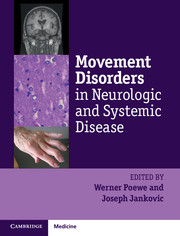Book contents
- Frontmatter
- Contents
- List of contributors
- List of videos
- List of abbreviations
- Preface
- Section I General principles
- Section II Movement disorders in systemic disease
- Chapter 4 Paraneoplastic movement disorders
- Chapter 5 Movement disorders of autoimmune origin
- Chapter 6 Movement disorders in systemic infections
- Chapter 7 Movement disorders in HIV- and AIDS-related central nervous system infections
- Chapter 8 Movement disorders in metabolic diseases in adulthood
- Chapter 9 Movement disorders in childhood metabolic diseases
- Chapter 10 Movement disorders in endocrinological diseases
- Chapter 11 Movement disorders in liver disease
- Chapter 12 Movement disorders in renal diseases
- Chapter 13 Movement disorders in hematological disease
- Section III Iatrogenic and toxic movement disorders
- Section IV Movement disorders in general neurology
- Section V Systemic complications of movement disorders
- Index
- Plate Section
- References
Chapter 11 - Movement disorders in liver disease
from Section II - Movement disorders in systemic disease
Published online by Cambridge University Press: 05 April 2014
- Frontmatter
- Contents
- List of contributors
- List of videos
- List of abbreviations
- Preface
- Section I General principles
- Section II Movement disorders in systemic disease
- Chapter 4 Paraneoplastic movement disorders
- Chapter 5 Movement disorders of autoimmune origin
- Chapter 6 Movement disorders in systemic infections
- Chapter 7 Movement disorders in HIV- and AIDS-related central nervous system infections
- Chapter 8 Movement disorders in metabolic diseases in adulthood
- Chapter 9 Movement disorders in childhood metabolic diseases
- Chapter 10 Movement disorders in endocrinological diseases
- Chapter 11 Movement disorders in liver disease
- Chapter 12 Movement disorders in renal diseases
- Chapter 13 Movement disorders in hematological disease
- Section III Iatrogenic and toxic movement disorders
- Section IV Movement disorders in general neurology
- Section V Systemic complications of movement disorders
- Index
- Plate Section
- References
Summary
The authors have no conflicts of interest related to this work. The authors shared in composing the initial draft and subsequent revisions of this manuscript.
Introduction
Movement disorders in individuals with liver disease can be divided into three broad categories.
The first category includes various systemic diseases which affect both the liver and brain coincidently, that is, hepatic and neurological dysfunction share a common etiology, but the liver disease itself does not cause neurological symptoms. Examples of this include alcoholism giving rise to cirrhosis and cerebellar degeneration, and Niemann-Pick type C, an autosomal recessive lysosomal storage disease that can result in hepatomegaly and involuntary movements, including dystonia, chorea, myoclonus, and parkinsonism. We refer the reader to other chapters of this text for information on this group of diseases.
The second category is limited to the metabolic liver diseases, in which an enzymatic insufficiency or some other form of hepatic dysfunction gives rise to neurological symptoms, independent of hepatic failure or portosystemic shunting. The classic example of this disease type is hepatolenticular degeneration, an autosomal recessive disorder of hepatic copper metabolism, discussed below (and also covered in Chapter 11). Urea cycle disorders also fit into this category, since milder variants may present beyond infancy with ataxia, although coma and seizures are more characteristic features. In 2012, two research groups reported that mutations in the SLC30A10 gene, which encodes for a manganese transporter, are responsible for a syndrome of hypermanganesemia with dystonia, parkinsonism, cirrhosis, and polycythemia (Tuschl et al. 2012; Quadri et al. 2012). This disorder has not yet been fully characterized, but available data is provided below.
- Type
- Chapter
- Information
- Movement Disorders in Neurologic and Systemic Disease , pp. 144 - 171Publisher: Cambridge University PressPrint publication year: 2014

